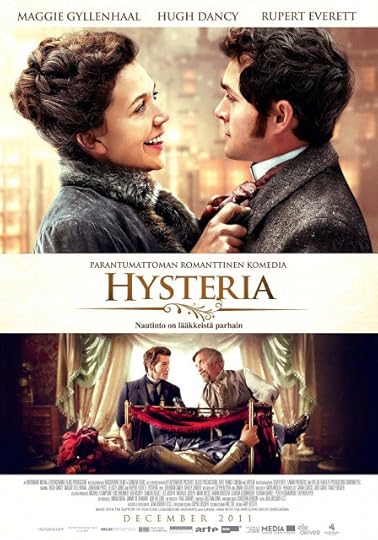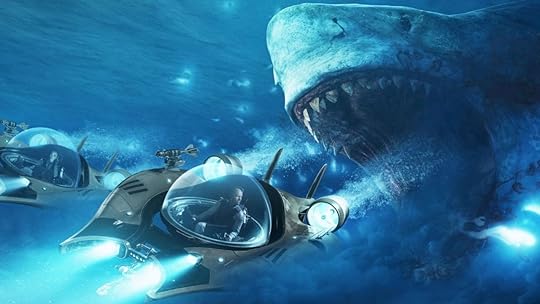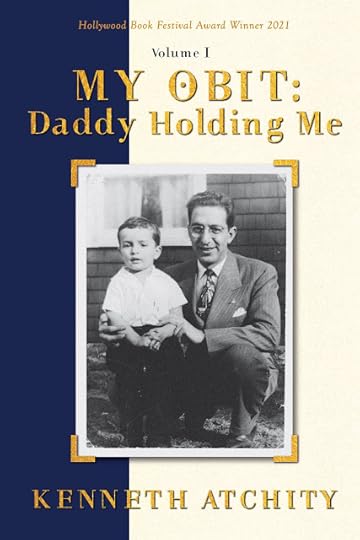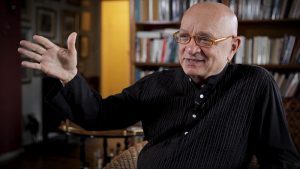Kenneth Atchity's Blog, page 44
August 1, 2022
Hysteria - Streaming on Hulu

HYSTERIA, a mischievously inspired romantic comedy set in the late 19th century, is based on the surprising truth of how Mortimer Granville came up with the world's first electromechanical vibrator in the name of medical science.
July 29, 2022
July 27, 2022
Kudos for Ken Atchity's My Obit: Daddy Holding Me

 Christopher Brian Halvorson•Writer/Producer 3 days agoI just finished reading the autobiography of Ken Atchity, who is best known for producing films, e.g. The Meg, Hysteria, and Angels in the Snow, and whom I’ve had the pleasure of working with on a few projects.
Christopher Brian Halvorson•Writer/Producer 3 days agoI just finished reading the autobiography of Ken Atchity, who is best known for producing films, e.g. The Meg, Hysteria, and Angels in the Snow, and whom I’ve had the pleasure of working with on a few projects.In his book, Ken openly writes the greatest mystery of all, which is equally difficult to solve — family relationships, and the importance of namesake. With a Cajun French mother and father of Lebanese heritage, he grew up with a unique mix of culture, food, and strict Jesuit Catholicism. With jokes and recipes included, Ken shares his story of becoming a Yale-educated literature professor, who dared to venture into the impossible business of moviemaking (“Fake it till you make it” still requires tremendous smarts, hard work, and determination).
Without trying, Ken gives great advice on life, career, and the approach to happiness. I highly recommend the book to anyone interested in the story behind the story merchant himself. (Had no idea the ancient Phoenicians brought the alphabet in their trading ships, which is how he named his company).
Thanks, Ken, if you’re reading this post!
PS— I’m jealous that you received a letter from Jorge Amado after reviewing his book for the LA Times. Gabriella, Cinnamon and Clove is one of my all-time favorites. JKMARAO’RB’s!
July 25, 2022
ERASED Streaming on HBO Max!

In "The Expatriate aka Erased" Aaron Eckhart plays a former CIA agent who moves to Belgium, trying to make a fresh go of things as the relationship with his 15-year-old daughter (Liana Libreto) has crumbled. Working for a multinational corporation as a security head, he arrives to work one day to find that the corporation doesn’t actually exist and everyone he works with has vanished. He discovers his assistant is actually a trained operative trying to kill him. On the run with his daughter, the experience forces the two to trust and work with one another. Olga Kurylenko will play his former CIA partner and lover trying to track him down.
July 22, 2022
About The Meg

The Meg made $145.4 million in the U.S. and Canada and $384.8 million in other countries. It made a total of $530.2 million worldwide, even though it cost between $130 and 178 million to make.
At first, it was thought that it would make between $20 and $22 million in its first weekend in 4,118 theatres in the U.S. and Canada.
Analysts thought the movie would do better than the low $20 million predictions because it made $4 million on Thursday night. Estimates for the weekend went up to $40 million after the first day, when it earned $16.5 million.
It went on to open with $45.4 million, which was more than any other movie and the best opening of Statham’s and Turteltaub’s careers. It made $21.5 million in its second weekend and $13 million in its third. Both times, Crazy Rich Asians made more money than it did, so it came in second.
The movie opened in 96 other countries and territories to the tune of $101.5 million worldwide opening of $146.9 million. In China, the film’s co-producer made $50.3 million from 12,650 screens in the first weekend and was ranked #3. Mexico ($6.2 million), Russia ($5 million), the U.K. ($4.4 million), Spain ($2.4 million), and the Philippines ($2 million) also had very successful openings.
The Meg is a science fiction action movie that came out in 2018. It was directed by Jon Turteltaub and written by Dean Georgaris, Jon Hoeber, and Erich Hoeber. It was loosely based on Steve Alten’s 1997 book Meg: A Novel of Deep Terror. Jason Statham, Li Bingbing, Rainn Wilson, Ruby Rose, Winston Chao, and Cliff Curtis all have roles in the movie.
A group of scientists on a rescue mission on the floor of the Pacific Ocean runs into a 75-foot-long (23-m) megalodon shark. Walt Disney Studios bought the rights to turn the book into a movie in the 1990s, but the project took years to get off the ground. In the end, Warner Bros.
Pictures bought the rights, and the movie got the go-ahead in 2013. In September 2014, Turteltaub and most of the cast signed on. Filming started in New Zealand and Sanya, China, and ended in January 2016. Both the United States and China made the movie.
The Plot of The Meg Movie

Jonas Taylor, a rescue diver, is trying to save the crew of a damaged nuclear submarine when he sees the hull being hit by something he doesn’t know. Taylor has to run away because two of his crew members are stuck in the broken submarine. He knows that if he tries to save them, everyone he has already saved will die.
A fellow survivor, Dr. Heller, doesn’t believe what he says because he thinks Taylor got drunk and scared because of the pressure.
Five years later, billionaire Jack Morris meets Dr. Minway Zhang at a place called Mana One, an underwater research facility. Zhang and his oceanographer daughter Suyin are in charge of a mission to find the deepest part of the Mariana Trench, which is hidden by a thermocline of hydrogen sulfide.
Lori, Taylor’s ex-wife, and the scientists Toshi and “The Wall” drive the mission submersible. They find a lot of plants and animals that they have never seen before below the thermocline. However, when a large, unknown creature attacks the submersible, it loses contact with Mana One.

James “Mac” Mackreides, the operations manager for Mana One and an old friend of Taylor’s, suggests sending Taylor down to try to save people. Zhang and Mac go to Thailand to find Taylor, even though Heller, who is now part of the Mana One crew, is against it.
At first, he is skeptical but changes his mind after listening to a recording of the conversation between Lori, her crew, and Mana One. Suyin tries to save them while they are away, but a giant squid attacks her. Before the squid could crush her submarine, a giant shark killed it.
Taylor breaks through the thermocline and swims to the sunken submersible because he promised to help. When the shark returns and attacks the submersible before everyone has left, Toshi gives his life so the others can escape.
July 20, 2022
1 Field & Beyond with John Stuart Reid.
We're pleased to launch , this time with
John Stuart Reid.
Watch the trailer:
In "The 1 Field" we brought you nine minutes of the groundbreaking experiment that we documented.
Now, for the first time, we are revealing a 150 minute documentation that we couldn't include in the film. Moment by moment, the entire experiment that John conducted with Anders and Cacina, until the amazing, groundbreaking results, or as we like to call them, "historic" results, that expose more secrets from the wondrous world of sound.
Another experiment we're revealing for the very first time, in real time – how a harmonious and beautiful shape is enmeshed in blood and remains there for many minutes after the sound that created it stopped. Far-reaching ramifications to this phenomenon and we're merely at the tip of the iceberg of the mysterious world yet to be uncovered.
In 2019, when we documented this, John asked not to make the footage public. It was too innovative, with extremely major implications as he explained.
For the launch of we got permission to reveal it here for this first time. It's stunning!
You can view all this material for at least one year, but you can download the original soundtrack that was played for the blood in real time.
It's the soundtrack that created the seminal effect on the amount of living cells and the oxygen level and vitality of the blood.
You can play this soundtrack for your blood cells whenever you're in need of energy:)
You can also download two articles by John:
Sound Therapy 101 and 201 that distill in easy-to-understand language the history of sound therapy and music medicine, and the biological mechanisms.
And!!!
A discount coupon just for you for DNA Voice Signature.
John Stuart Reid explains in his own words:
Your DNA not only determines your body shape, facial features and the color of your eyes and hair, it also shapes your unique voice.
Now, your personalized DNA Voice Signature can be imaged using our exclusive CymaScope technology.
In a seamless blend of science and art, we will image your voice and supply a digital file in colors of your choice that you can have printed at any print.
We invite you to dive deep into the magical world of sounds that
John Stuart Reid created.
is much more than the sequel to The 1 Field

Tsipi Raz - John Stuart Reid
And the team of “The 1 Field”
July 18, 2022
Congratulations to Story Merchant's Own Yasemin Isil's Let's Bring Them Alive's Official Selection to the Oscar qualifying LA Shorts International Film Festival!

Creating a Legacy
LA Shorts honors those individuals who have achieved excellence in short films. The festival has become the industry standard for showcasing and awarding undiscovered talent.
LA Shorts International Film Festival ranks among the most prestigious and largest short film festivals in the world. The festival is accredited by the Academy of Motion Pictures Arts & Sciences, the British Academy of Film and Television Arts and the Academy of Canadian Cinema and Television and The Academy of Motion Picture Arts and Sciences of Spain.
Now in its 26th year, LA Shorts is the longest-running short film festival in Los Angeles.

Let's Bring Them Alive Scheduled WEDNESDAYJULY 27, 3:15PM PROGRAM 36
PURCHASE TICKETS

Cast: @unbothered.tbh @mat_szymko @themadwin
Directed By @elication
Written & Produced by Yasemin Isıl & Azize Erim
Line Producer @ozozmens
Director of Photography: @alexismendezfilms
Production Designer: @jdizo
Music By: @serkan_celikoz
Paint Artist @fatal.attraction
Editor: @rjeanpierre
Assistant Editor @ricardoperezmedia
Colorist: @coloristroy @reasonstudio.co
Post Sound Mixer: Michael Archacki
VFX @duncanrawlings
VFX Intro: @maxcoltt
1st AC: @theeprodigy
Gaffer: Jeremy Guico
Key Grip: @doomdoer
G&E Swing: @cameronhinojos
Art Director: Brandon Bill Allen
Art Assistant : @eyerenuh
Production Sound Mixer: @80884
Boom Operator: Nate Ipanag
Production Coordinator: @souqilaith
Production Assistant: @brody.bogert_
Site Representative: @paul_rush_maine
Special thanks to our Executive Producer @storymerchant @ken_atchity and @samsskelton
July 15, 2022
Story Merchant CEO Dr. Ken Atchity goes live with Denise Griffitts on Your Partner In Success Radio!

Tune in here: https://lnkd.in/gsAKysHZ
Ken Atchity - My Obit: Daddy Holding Me
‘’Know Thyself’, attributed to Socrates, was carved into stone at the entrance to Apollo’s temple at Delphi in ancient Greece, according to legend. Now Dr. Kenneth Atchity—film producer, literary manager, novelist, multilingual Yale doctorate holder, former classics professor at Occidental College in L.A., and author of twenty-plus books—embraces Socrates’ maxim full-tilt in his thought-provoking, heartfelt, and brilliantly composed autobiography—volume one of a two-volume opus (the second in the works, according to the author).
“Story Merchant” Ken Atchity, head of Story Merchant Books and Atchity Productions, has more than 40 years of experience in the publishing world, and over 20 years in entertainment. His books include, most recently, My Obit: Daddy Holding Me, Japanese-In Law: Words and Phrases for Day-to-Day Living (with Keisaku Mitsumatsu), The Messiah Matrix and Seven Ways to Die (with William Diehl) and nonfiction books for writers at every stage of their career. Based on his teaching, managing, and writing experience, he's successfully built bestselling careers for novelists, nonfiction writers, and screenwriters from the ground up. His bestselling clients have led him to all areas of communications.
His is a truly fascinating story/journey and you can listen as we chat LIVE!
Late Night Health Radio on Fathers & Their Sons with Ken Atchity

“ Story Merchant” Ken Atchity, head of Story Merchant Books and Atchity Productions, has more than 40 years of experience in the publishing world, and over 20 years in entertainment.
Story Merchant” Ken Atchity, head of Story Merchant Books and Atchity Productions, has more than 40 years of experience in the publishing world, and over 20 years in entertainment.
“At the prompting of a marketing friend, I was advised to title this book, My Intensely Madcap, Lebanese/Cajun, Jesuit-Schizoid, Terminally Narcissistic, Food-Focused, East Coast/West Coast, Georgetown/Yale, Career-Changing, Cross-Dressing, Runaway Catholic Italophile, Paradoxically Dramatic, Linguistically Neurotic, Hollywood Academic, ADD-Overcompensating, Niche-Abhorring, Jocoserious Obit. But when my designer pointed out that title wouldn’t fit on the spine, much less on any public display list, I changed my mind. Again! The story of my life. Which this is at least the first volume of. I hope it makes you laugh, spares you some of my grief, and leads you to insist on telling your story to anyone who will listen,” shares prolific story merchant Ken Atchity with Late Night Health’s Mark Alyn about his MY OBIT: Daddy Holding Me, Volume 1, published by Story Merchant Books, $19.95 softcover.
Prolific story merchant Ken Atchity is a writer, editor, professor, producer, literary manager who’s spent his life in the world of stories. He’s written over 20 books, produced more than 30 films for television and theater, and made hundreds of Hollywood and traditional publishing deals for his writer clients – including nearly 20 New York Times bestsellers.
His films, include: The Meg (Jason Statham, Warner Bros—over $500 million worldwide!), Angels in the Snow (Kristy Swanson, UP! Channel), Erased (Aaron Eckhart; Informant), Hysteria (Maggie Gyllenhaal, Hugh Dancy; Informant), The Lost Valentine (Betty White, Hallmark Hall of Fame), the Emmy-nominated The Kennedy Detail documentary (Discovery), Gospel Hill (Danny Glover; Fox), The Madam’s Family (Ellen Burstyn, CBS), Joe Somebody (Tim Allen; Fox), Life or Something Like It (Angelina Jolie: Fox), Shadow of Obsession (Veronica Hammel, NBC), The Amityville Horror (NBC), and the Shades of Love movies for Cinemax-Warner Brothers International.
Learn more at https:///www.thestorymerchant.com.
Listen to Ken and Mark here: https://www.latenighthealth.com/fathe...
July 13, 2022
Writers Lifeline: Book to Film Do It Yourself

In the past couple of years, I’ve been involved in turning writers into filmmakers. As an author, one of the hardest things about trying to get a film made based on your work is that you really are going to producers hat-in-hand. You’re carrying around what’s called a “naked property”—a naked script, a naked book. If you’ve published an e-book, then it’s even worse than naked. Hollywood knows that an e-book is not the same thing as a traditional book, and they don’t want anything to do with it, at least not unless you’ve sold thousands and thousands of copies.
The obvious solution is to clothe your book—make it not be naked. How do you do that? Get a major director interested. To most people, it seems like that would take a miracle. But if you have a few connections, it might be easier than you think. Or you could get a major star or an investor interested. Any of those three will make your book jump to the front of the line.
We have an amazing situation in the United States. We have probably more talented writers than any country in the world with the possible exception of India. As a result, it is thousands of times harder to become a known writer here than it is in Canada or Mexico or Italy or many other countries in the world simply because there’s so much competition. Our market is the most jungle-like market imaginable, and the only thing that breaks through the crowd is success. And it’s usually success measured in sales. That’s what writers are up against, so you have to do whatever you can to make your book stand out. If you manage to get a book on The Today show, everybody knows that could be all the breakthrough you need. But it’s not an easy task, and it’s exactly why I spend a lot of my time doing strategic coaching for writers, trying to help them figure out how to bring attention to their work.



